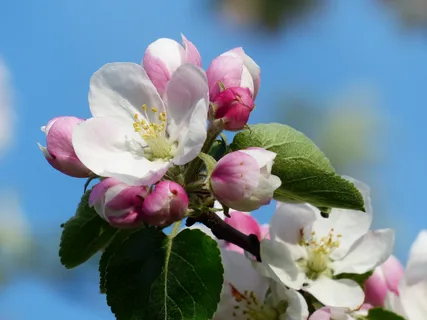Apple Blossom Flowers: From Bud to Bloom – A Visual Journey
The transition of apple blossom flowers from bud to bloom is a captivating natural process, marking the advent of spring and symbolizing renewal and growth. This visual journey through the lifecycle of apple blossoms not only highlights the intricate beauty of nature but also underscores the importance of these flowers in ecosystems and agriculture. Let’s embark on a detailed exploration of this transformative phase, illuminating each step from the initial budding to the full bloom of these enchanting flowers.
Daftar Isi
The Prelude to Spring: Initial Bud Formation
As winter’s grip loosens and the first signs of spring emerge, apple trees begin a remarkable transformation. The process starts with the formation of tiny buds, a promise of the splendor to come. These buds are the apple tree’s response to increasing daylight and warming temperatures, signaling the tree to awaken from its dormant state. Encased in protective scales, these nascent buds are the tree’s first step toward the reproductive phase, crucial for the cycle of life to continue.
The Awakening: Bud Swell
With the arrival of warmer days Apple Blossom Flowers, the buds begin to swell, an indication that the flowering process is imminent. This stage is characterized by a noticeable enlargement of the bud as it prepares to open. The swell is a result of increased water uptake and the expansion of cells within the bud, driven by hormonal changes within the tree. This phase of bud swell is a critical moment, as it sets the stage for the delicate blossoms that are soon to unfold.
The Unveiling: Bud Break
Bud break marks the moment when the protective scales that encase the bud start to open, revealing the first hints of color from the emerging flower. This stage is a testament to the resilience and determination of life, as the buds push through the remnants of winter to embrace the warmth of spring. The colors that peek through—ranging from the softest pinks to the purest whites—are a prelude to the visual spectacle that apple blossom flowers offer.
The Transformation: Bloom Development
Following bud break, the blossoms rapidly begin to develop. This stage is characterized by the unfolding of petals, revealing the flower in its full glory. The bloom development phase is when the apple tree is at its most vulnerable, as the delicate blossoms are susceptible to frost and adverse weather conditions. However, it is also a period of immense beauty, as the trees become adorned with flowers, transforming orchards into breathtaking landscapes of floral abundance.
Full Bloom: A Spectacle of Beauty
The culmination of this visual journey is the full bloom of apple blossom flowers, a spectacular display of nature’s artistry. Full bloom occurs when the majority of the blossoms on the tree have opened, creating a dense canopy of flowers. This stage is not only visually stunning but also a crucial period for pollination. Bees and other pollinators are attracted to the flowers by their vibrant colors and enticing fragrances, facilitating the cross-pollination necessary for fruit development.
The Role of Pollinators: Bees at Work
Pollination is a vital part of the apple blossom’s lifecycle, and it is during full bloom that this activity reaches its peak. Bees, the primary pollinators of apple trees, move from flower to flower, collecting nectar and pollen Lily lovers. As they travel, pollen from the male parts of the flower (anthers) sticks to their bodies and is subsequently transferred to the female parts (stigmas) of other flowers, fertilizing them and setting the stage for fruit development.
Post-Bloom: Setting the Stage for Fruit
After the spectacle of full bloom, the petals of the apple blossom flowers begin to fall, leaving behind the fertilized ovary of the flower, which will develop into an apple. This stage marks the transition from floral beauty to the promise of fruit, highlighting the apple blossom’s role in the lifecycle of the apple tree. The fallen petals carpet the ground beneath the trees, a reminder of the ephemeral nature of beauty and the continuous cycle of growth and renewal.
Apple Blossoms in Eastern Cultures
In many Eastern cultures, flowers are imbued with profound meanings, and apple blossoms are no exception. In China and Japan, apple blossoms are symbols of feminine beauty and love. They are often associated with the celebration of life and the appreciation of fleeting beauty, echoing the themes of mono no aware in Japanese aesthetics—the awareness of the impermanence of things and the bittersweet beauty of transient moments.
The Role of Apple Blossoms in American Culture
The apple blossom holds a place of honor in American culture as well. It is the state flower of Arkansas, symbolizing the importance of the apple industry to the state’s economy and culture. The designation of the apple blossom as a state symbol reflects the broader American appreciation for agriculture and the beauty of nature’s bounty.
Apple Blossoms and the Language of Flowers
In the Victorian era, the language of flowers, or floriography, became a popular means of communication, with various flowers and floral arrangements used to convey secret messages. In this context, apple blossoms were symbols of preference, signifying the sender’s preference for the recipient over others. This subtle language allowed individuals to express feelings of love and affection in a society that valued restraint and propriety.
Festivals and Celebrations
Across the globe, the blooming of apple blossoms is celebrated with festivals and rituals that welcome spring and express gratitude for the beauty and abundance of nature. In Japan, while cherry blossoms receive much attention, apple blossoms are also celebrated in certain regions, with people gathering to view the flowers in a practice known as hanami. These celebrations often reflect the community’s acknowledgment of nature’s cycles and the importance of seasonal change.
Apple Blossoms in Literature and Art
The apple blossom’s symbolic richness has made it a favored subject in literature and art, embodying themes of beauty, transformation, and the ephemeral nature of life. Poets and artists have often drawn on the image of the apple blossom to evoke the tender beauty of spring and the transient, fragile nature of existence Lily lovers. In paintings, apple blossoms are frequently depicted as a motif representing renewal and the fleeting moments of life’s stages.
Modern Cultural References
In contemporary culture, apple blossoms continue to symbolize love, beauty, and the renewal of life. They appear in modern literature, music, and art as symbols of new beginnings and the hope that springs from love and affection. The apple blossom’s enduring appeal lies in its beauty and the depth of meaning it has accumulated over centuries of human experience.
The Importance of Apple Blossoms in Ecosystems
Beyond their visual beauty, apple blossoms play a significant role in ecosystems. They provide a critical food source for pollinators early in the season, supporting biodiversity. Additionally, apple trees contribute to the health of the environment by producing oxygen, improving air quality, and offering habitat and food for various wildlife species.
Conclusion
The journey of apple blossom flowers from bud to bloom is a mesmerizing display of nature’s resilience and beauty. Each stage of the process, from the initial bud formation to the full flowering and subsequent fruit setting, plays a critical role in the lifecycle of the apple tree and the broader ecosystem. This visual journey not only offers a glimpse into the intricate processes that underlie natural phenomena but also serves as a reminder of the interconnectedness of life and the importance of preserving and appreciating the natural world around us. As we witness the annual transformation of apple trees, let us cherish these moments of natural splendor and recognize the



